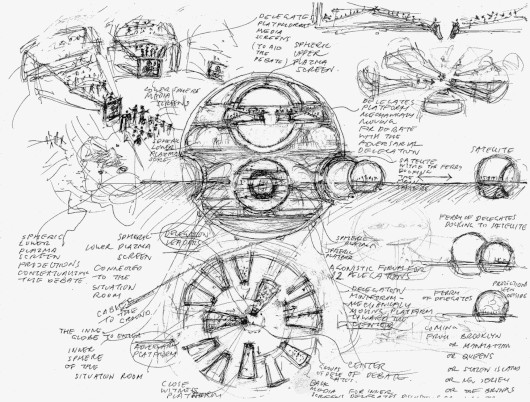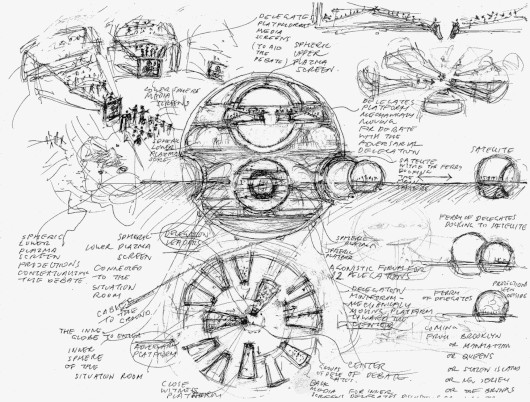2008

The design was a kind of “critical supplement” to the World Trade Center Site Memorial competition. Instead of locking the past away in a monument, the artist proposed a critical reflection on the causes of the tragedy in ethical and political terms. In reference to the Biblical “cities of refuge,” he proposed a site of active commemoration: a globe-shaped building moving on water and slowly revolving. Situated between the World Trade Center, Ellis Island, Governor’s Island, Battery Park, New Jersey, Manhattan, Brooklyn, and Staten Island, the structure would remain in a symbolic and spatial relationship with the Statue of Liberty and Ellis Island, once the entry point for immigrants arriving in New York City and today the site of a museum of immigration. The Memory Site would consist of seven “components,” including spaces devoted to historical, philosophical, and interdisciplinary studies of terrorism, an information and communications center, a monitoring room to follow the changes in, and proliferation of, terrorist activity and ideology, an open agora for public debates with a place for cultural and artistic projects, support programs offering legal and medical aid and political support, a center in the city to coordinate cooperation with the media and information exchange, an archive of commemoration projects, and a global and local media center including TV and radio studios and a press center.
Its aim is to create a place for a more active, critical, and discursive memory of the September 11 attack, examined in its historical and political context, in the light of the military action taken in its wake, and its domestic and international fallout. The memorial will be a place for operative memory, memory in action. It will be an interrogative and “agonistic,” not antagonistic, institute of memory, a public forum and base from which to initiate new transformative projects. It is only through such work that a memorial can contribute to the prevention of global injustice, arrogance, ignorance, and disrespect, which, if not stopped, will continue to ignite anger and provide fertile ground for new attacks.
It will be a working memorial, an active, engaged and engaging, socially inclusive institution, a network as well as an organization. Its public programs and events in remembering and recollection will aim to inspire, provoke, and assist in the process of raising consciousness and knowledge of our unintentional role and indirect implication in the misery of the world, even when our action and its effects unfold at a distance, in terrains and territories little known to us.
The founding reference for this memorial is the ancient Jewish notion of “half-guilt and half-innocence” and the biblical blueprint for “Cities of Refuge” related to it. In one of his Talmudic lectures, ethical philosopher Emmanuel Levinas reintroduced and actualized this notion as a powerful ethico-political metaphor for our Western globalizing attitude and the concomitant lack of consciousness of the crimes and injustices unintentionally (or half-intentionally) committed towards those less fortunate and less prosperous than ourselves. In the face of
continuing and seemingly uncontrollable and unavoidable bloody conflicts and man-made catastrophes, further critical re-actualization of the ethico-political paradigm and metaphor of Cities of Refuge remains an imperative for our social survival and for the advancement of our civilization. In this global context any political and ethical consciousness of our halfguilt and half-innocence gained is a valuable start, and a necessary, albeit insufficient, first step. Our goal is to move beyond that consciousness, beyond even an intelligent emotional reflection, beyond a psychoanalytical process of “working through” the trauma of September 11. One must take a further step.
Krzysztof Wodiczko, City of Refuge. A 9/11 Memorial, eds. Mark Jarzombek, Metchild
Widrich, London, Black Dog Publishing, 2009



